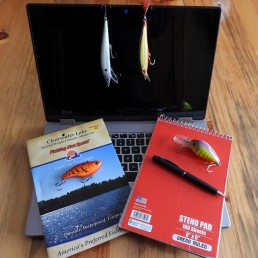Start Your Open-Water Season Now
SHARE THIS POST
As winter runs its course across the Midwest, you cannot help but think of spring and the coming open-water season. It is early, but use this downtime to get ready for the upcoming open-water season. Depending on where you live in the Midwest, spring will soon begin taking hold in your area.
Start by picking areas to begin your open-water fishing season. These areas can be related to past traditions, or perhaps you want to explore a new area or body of water this year. I pick different areas based on state location. Many times, if you get too far north, these areas may still be a few weeks away from good open-water opportunities.
Once you have selected a few, turn to that state’s DNR webpage to look at the information for these waters. State DNR information is one of the most underutilized sources for new lake makeup and information. Many states track water conditions and lake makeup. Other information may include stocking records and creel netting information. This will give you a good idea of what these waters offer. Do a few additional internet searches to see what else you can find out about these waters.
If it is a popular lake for tournaments, you can also gather information another way. Search past tournament records to see how many big fish were weighed in and how many pounds it took to win. This will give you a snapshot of the lake conditions.
Next, look at a lake map to get an idea of how the lake lays out. You can do this in a few diverse ways, and to tell you the truth, you can get a little something from each option.
Lake map books offer a look at the lake and give you some back information. Products like MN Map Connection can be a good start.
Google Earth is my next source of information, giving me a satellite view of the lake and surrounding areas. Features like shallow, hard spots stick out in these shots, and you can get a quick look at all incoming and outgoing water sources that attract walleyes in one glance. That will cut search times down as you’re looking for bodies of water to target.
The next level I look at is Johnson’s Outdoors One Boat Network app. If you pay the yearly fee of $24.99, you can download LakeMaster chips to get highly detailed maps at your fingertips. I do most of my work on this app when exploring new waters. I can also drop a waypoint on the app to transfer right onto my Humminbird units and cut my transfer time in half. Once they are on my Humminbird units, I am ready to start my search on the water when the time comes.
Are you enjoying this post?
You can be among the first to get the latest info on where to go, what to use and how to use it!
Another app is the Navionics Map app, which lets you look at all lakes up close. The drawback with this is, if you log waypoints, I have not figured out a way to get them onto my units other than to write them down and load them into my unit one by one.
Key areas to look for
When getting my first look at these new waters in the boat, I am going to target in spring, I will look for and concentrate on finding spawning areas the walleyes will use. This gives me a three-step pattern that I can follow.
Walleyes will sit in deeper water areas outside these spawning areas, waiting for the water to warm before moving up to these holding areas and getting ready to spawn. Once they start to spawn, more walleyes will move into these areas and come into the shallows in waves. When the first wave is done spawning, they will hold in the area and protect the new eggs before they move towards deeper water where they came from to recuperate and begin to put on the feed bag as the next wave comes up and starts its process.
The walleyes will hold in these areas for a few weeks if the weather is stable. If it hits a few bumps (cold fronts) along the way, this will slow the process down a little, but it will pick back up again in a day or two, depending on the sun and the accompanying weather conditions.
Three key areas to look for walleyes at this time will be neck-down areas (channel areas off the main lake that allow water to flow between the two bodies of water), windswept rocky points, and shallow rock humps. In all of these places, stickbaits are a top choice, however, if the current flows toward you, you’re better off switching to a jig to get your lure to the feeding walleyes.
I hope these pre-season walleye thoughts help you get ready this year. Use this time before the season to get your pre-work in and help set up what you need to get a jump on this year’s open-water season.
If you enjoy walleye fishing, you’ll find plenty of helpful walleye fishing insight in every issue of MidWest Outdoors. Subscribe on our website.
MWO
SHARE THIS POST
You may also like...
Nothing found.
Did you enjoy this post?
You can be among the first to get the latest info on where to go, what to use and how to use it!
Scott Petersen
Scott Petersen has been writing for the past 30 years. A Minnesota native, he has a passion to fish all seasons on ice and open water. “One of my main goals is to teach people how to fish through my articles and sport-show seminars.”
